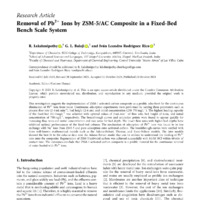Removal of Pb2+ Ions by ZSM-5/AC Composite in a Fixed-Bed Bench Scale System
Item
-
Tipo do ITEM
-
Artigo Ciêntifico
-
Título do Artigo
-
Removal of Pb2+ Ions by ZSM-5/AC Composite in a Fixed-Bed Bench Scale System
-
Descrição
-
This investigation suggests the implementation of ZSM-5 activated carbon composite as a prolific adsorbent for the continuous elimination of Pb2+ ions from water. Continuous adsorption experiments were performed by varying three parameters such as process flow rate (2-6 mL min-1), bed height (2-6 cm), and initial concentration (250–750 mg L-1). The highest loading capacity of the fixed-bed 213.3 mg L-1 was achieved with optimal values of 2 mL min-1 of flow rate, bed height of 6 cm, and initial concentration of 750 mg L-1, respectively. The breakthrough curves and saturation points were found to appear quickly for increasing flow rates and initial concentration and vice versa for bed depth. The lower flow rates with higher bed depths have exhibited optimal performances of the fixed-bed column. The mechanism of adsorption of Pb2+ ions was found to be ion exchange with Na+ ions from ZMS-5 and pore adsorption onto activated carbon. The breakthrough curves were verified with three well-known mathematical models such as the Adams-Bohart, Thomas, and Yoon-Nelson models. The later models showed the best fit to the column data over the Adams-Bohart model that can be utilized to understand the binding of Pb2+ ions onto the composite. Regeneration of ZSM-5/activated carbon was achieved successfully with 0.1 M HCl within 60 min of contact time. The outcomes conclude that ZSM-5 activated carbon composite is a prolific material for the continuous removal of water loaded with Pb2+ ions
-
Abstract
-
This investigation suggests the implementation of ZSM-5 activated carbon composite as a prolific adsorbent for the continuous elimination of Pb2+ ions from water. Continuous adsorption experiments were performed by varying three parameters such as process flow rate (2-6 mL min-1), bed height (2-6 cm), and initial concentration (250–750 mg L-1). The highest loading capacity of the fixed-bed 213.3 mg L-1 was achieved with optimal values of 2 mL min-1 of flow rate, bed height of 6 cm, and initial concentration of 750 mg L-1, respectively. The breakthrough curves and saturation points were found to appear quickly for increasing flow rates and initial concentration and vice versa for bed depth. The lower flow rates with higher bed depths have exhibited optimal performances of the fixed-bed column. The mechanism of adsorption of Pb2+ ions was found to be ion exchange with Na+ ions from ZMS-5 and pore adsorption onto activated carbon. The breakthrough curves were verified with three well-known mathematical models such as the Adams-Bohart, Thomas, and Yoon-Nelson models. The later models showed the best fit to the column data over the Adams-Bohart model that can be utilized to understand the binding of Pb2+ ions onto the composite. Regeneration of ZSM-5/activated carbon was achieved successfully with 0.1 M HCl within 60 min of contact time. The outcomes conclude that ZSM-5 activated carbon composite is a prolific material for the continuous removal of water loaded with Pb2+ ions
-
Língua do arquivo
-
inglês
-
Data da Publicação
-
Ano 2021
-
Palavra-chave
-
Remoção de Íons Pb2
-
Sistema de Balança de Bancada
-
ZSM-5/AC
-
Autores
-
R. Lakshmipathy
-
G. L. Balaji
-
Leandro Rodríguez Rico
-
Local
-
ITEGAM - CUBA, 2021


